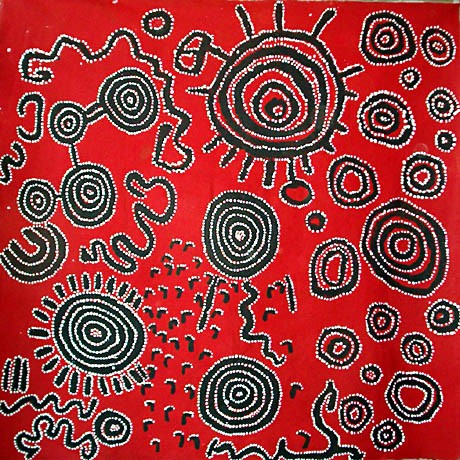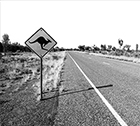Over the next couple of weeks I want to have a closer look at what is a poorly recognised phenomenon – the collective claiming of rights to and possession of country by Aboriginal people through art – particularly painting.

Most contemporary Aboriginal artwork is inextricably linked to place – a majority of paintings that you’ll see in galleries or on exhibition are expressions of the artist’s links to a particular place – most often through birthrights or through religious affiliations, rights and responsibilities.
Here I want to briefly examine three, and there may well be many more, recent collective accounts of connections to country, individual and communal, through the medium of painting. I note that two dimensional artworks are innately related to the many other ways – song, ceremonial practice and dance among others – that Aboriginal people use to express connections to country, and am aware that these have been used in the past as evidence in land claims, but in the three cases I will look at paintings have played a role not just by providing evidence in support of each claim but also by unifying the claimants through a common medium.
I’ve had a copy of Scott Cane’s “Pila Nguru: The Spinifex People” (2002, The Fremantle Arts Centre Press) sitting on my shelves for a while now and haven’t really managed to get around to having a good look at it until recently. Pila Nguru – the term is self-descriptive of the Spinifex People whose claim to land the book details – is a collaborative effort, with Cane providing much of the text and the native title claimants and artists detailing their connections to their country through art and stories.
Pila Nguru outlines the ancient historical connections of the Pila Nguru with their country and their dispossession from it in the 1950’s when their country was chosen, without their knowledge or consent, for the conduct of the British atomic testing program at Maralinga.
Cane documents their gradual return to and re-establishment on their country and their determination in the early 1990s to use the recently recognised (in Australian law at least) of their native title rights and interests in their land as a means of recognition of their ancient connections with it.

Cane outlines the background to the early stages of the Spinifex People’s native title application that commenced with a series of meetings with government representatives and miners in the 1990’s after which they:
…returned to their country. They mapped their territory and met with their kinsfolk to the north and east to explain their intentions…and with the support of the Ngaanyatjarra Council, the native title application of the Spinifex people was submitted in October 1995.
This map (at p. 84 of Pila Nguru) of the Tjukurrpa tracks within the claim area illustrates the richness and complexity of the Spinifex People’s knowledge and religious beliefs and practices in their country, and, by necessary implication, that of their neighbours. Documenting them – whether from an Aboriginal perspective by way of paintings – or from a western perspective by way of evidence admissible to the tribunal, was no small enterprise.
Cane notes at p. 86:
No non-Aboriginal person has done enough systematic field work with the Spinifex People to understand the geographic intricacy, sanctity and philosophical depth of Spinifex Tjukurrpa other than to appreciate that there is a lot of it, that it is extremely well known by them and that it is of the utmost importance to them.
As regular readers of The Northern Myth would know, I have a particular fascination with what Aboriginal people know of the birds that they share their country with. The stories that often accompany their paintings have proved to be a rich source of such material, and Pila Nguru is a particularly good example.
At page 86 the book relates the Tjukurrpa of Wati Kipara, the Bush Turkey man, (Australian Bustard, Ardeotis australis) which, as you can see from map of the various Tjukurrpas above, traverses the country of the Spinifex People:
The Bush Turkey Tjukurrpa is one of two major Tjukurrpa to pass through the country of the Spinifex People. It is a Tjukurrpa that is seen by other Western Desert people as belonging to the Spinifex people…The Wati Kipara…involves the travels of an old Bustard who attempts to steal the world’s fire and drown it in the ocean at Madura, on the shores of the Nullabor Plain. The Bustard is watched by his two sons, who hover in the sky as stars. They snatch the fire before it is drowned in the sea and drag the Old Man out of the water, north across the Nullabor Plain and back to the Spinifex homelands, where he slowly dies. His spirit resides in the central north of the homelands. His sons then take the fire and distribute it, with great celebration, to all the inhabitants of earth.
…
The Wati Kipara Tjukurrpa involves excruciating physical punishment, murder, betrayal, sex, deceit and intrigue, but the details of these events remain secret and privy only to senior men.
Like most native title matters the Spinifex People’s claim soon became mired in a web of meetings…and more meetings:
Negotiations then commenced to determine details of tenure and to define management arrangements for such things as land use and conservation, health and safety, resource development, mining, education, access and council representation. Negotiations were slow, retarded by political unease and confusion associated with other native title determinations in the federal courts, as well as amendments to the Native Title Act. Spinifex frustrations ebbed and flowed. Why did things take so long? Would all the old people be dead before the Spinifex People had recognition of their rightful ownership? But the political will was maintained and in July 1998 a framework agreement was completed and ready for signing.
Early on in the native title claim process the centrality of painting the country was made clear through the establishment of the Spinifex Art Project, which was:
…established in 1996 to record and document ownership of the Spinifex area. The community’s aspirations for the initial [painting] project were always quite clear – produce artworks which in themselves showed ownership of Spinifex country. Just as the land claim was formulated and articulated around places of birth, so was the painting project. A ‘map’ of Spinifex country birthplaces reveals the clear link between people and country. At one level the paintings directly relate to this theme that the broader concepts of traditional ownership, responsibility for country and knowledge of country can all be glimsped through a sketch of where people were born…The painting project rapidly grew to more widely portray the traditional ownership of the Spinifex area. Following the success and enthusiasm of the initial burst of documentation painting, the community produced a series of ten large paintings to be bequeathed to the people of western Australian a symbolic exchange of paintings for land when the final land agreement was reached…Together the ‘government’ paintings provide a striking record of the geographical and cultural heartland at the centre of the Spinifex land agreement.
 On the 28th of November 2000 at Tjuntjuntjara in the Spinifex country Chief Justice Black of the Federal Court delivered his Orders in favour of the Spinifex people. He noted in part:
On the 28th of November 2000 at Tjuntjuntjara in the Spinifex country Chief Justice Black of the Federal Court delivered his Orders in favour of the Spinifex people. He noted in part:
The Spinifex People describe themselves as the people who live in and own the Spinifex plains of the Great Victoria Desert between the Nullarbor Plain and the foothills of the Warburton Ranges. They call themselves, if anything, the Anangu tjuta pila nguru meaning the Aboriginal people (Anangu) many (tjuta) spinifex (pila) from (nguru). Dr Cane comments that a review of the historical records reveals that this is a consistent and reliable means of geo-cultural identification, which accurately associates the claimants with the country they are claiming.The Spinifex People have been at one with the land they claim for a very, very long time. The archaeological evidence suggests the emergence of a rudimentary nomadic society in the Western Desert at least 20, 000 years ago. How old the traditions of the Spinifex People are remains largely unknown, but Dr Cane refers to a Tjukurrpa (for present purposes – but inadequately – a tradition) that appears to relate to the postglacial rise in sea levels across the Nullarbor Plain between 15, 000 and 7, 000 years ago.
…
But it was the atomic testing program at Maralinga in 1952 and 1956 that brought with it the first contact between most of the Spinifex People and the western world. Changes to land tenure in relation to the use of the existing Aboriginal reserves and the establishment of a new nature reserve across the southern part of the Spinifex homelands in the 1960s also impacted upon the Spinifex People. The steps taken by the Spinifex People to return to their homelands after the closure of the Cundeelee Mission in the early 1980s are outlined in Dr Cane’s report. He then describes in considerable detail present day Spinifex society. Dr Cane’s report reveals the Spinifex People as a society of great complexity and antiquity; it reveals a society with a profound and enduring relationship with its land. It also reveals a people of great resourcefulness who have survived for countless generations in an environment in which few others could survive. It reveals a people who came out of their desert homelands with their traditional laws and customs intact and who have maintained their traditional laws and customs through the period of their recent contact with the world outside their desert homelands – a contact that has occurred within the lifetimes of many of us here today.
Apart from the other examples (that I’ll get to soon) of art being directly tied to the conduct and outcome of a native title claim I’ve not been able to find many other references apart from the following note about a group exhibition in 2004:
…Gough’s work, The Sub-dividing Games: Pogography 2000, is part of an exhibition that explores the links between indigenous art and native title. The exhibition, Native Title Business, contains 61 artworks by indigenous artists from around Australia…Some artworks in the exhibition were used in court for native title claims. Rosie and Alison Ferber say in the catalogue that they presented their acrylic on canvas painting, Arrweketye Atherre (Two Women), to the 1997 Federal Court hearing of the Alice Springs Arrernte native title application “to let the court know that we still carry on our culture“.
Over the next few weeks I’ll have a look at two other examples of art playing a part in the re-claiming – whether at law or as a metaphorical stamping of the foot onto the ground – from two very different parts of the country. One, like the Pila Ngura, is from Western Australia, the other is from the north-east coast of the Northern Territory.
Please post your comments, thoughts or suggestions about the story of the Spinifex People. If you want to see and learn more about the paintings shown above have a look at the online gallery at the Neil Murphy Indigenous Art gallery, from where those images come.









Crikey is committed to hosting lively discussions. Help us keep the conversation useful, interesting and welcoming. We aim to publish comments quickly in the interest of promoting robust conversation, but we’re a small team and we deploy filters to protect against legal risk. Occasionally your comment may be held up while we review, but we’re working as fast as we can to keep the conversation rolling.
The Crikey comment section is members-only content. Please subscribe to leave a comment.
The Crikey comment section is members-only content. Please login to leave a comment.